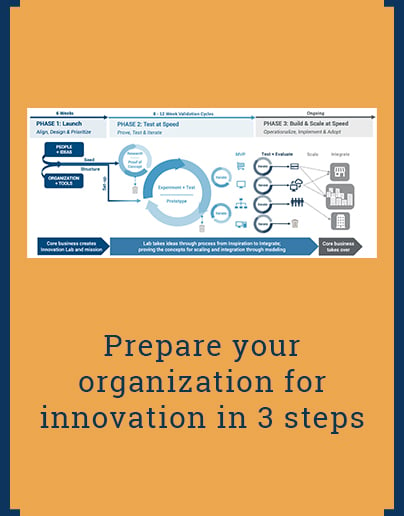90% of executives saying that long-term success depends on developing and implementing new ideas. The growing realization that new ideas are better fostered through deliberation rather than accidentally discovery is the reason we've seen innovation programs on the rise recently in organizations. While seemingly straightforward, there are lots of factors to get right when fostering innovation in the workplace
Building out and supporting innovation revolves around surfacing and prioritizing the right ideas, structuring organizationally to innovate, and executing with both speed and deliberation. On top of this, organizations must cope with the increasing pace of change that the marketplace demands to stay relevant.
The question we hear most often from executives in response to this is, “… but how do I start?”
Analyze your organizational current state
We’ve found that the best first step for setting up an innovation program is to align expectations for innovation across your stakeholders.
Start by conducting interviews with both the executive suite and department heads of areas impacted by innovation efforts (e.g. product, supply chain, IT, human resources, customer experience). Example questions to ask are:
- When we talk about repositioning the company to be more innovative, what does that mean to you?
- What activities should stop that may be preventing us? What should start to help us be successful?
- What happens today if someone has an innovative idea?
While you may start with a set group of core questions, don’t hesitate to “pull the thread” a little when you get an interesting or unexpected response. Those one-off conversations can be the beginning of a key insight.
The goal is to become absolutely clear on why the organization is struggling to innovate today, what obstacles people see along the path to innovation, and also how stakeholders see innovation supporting the company’s mission and goals.
Note - Current state analysis also tends to reveal a lot of great ideas people have already but haven’t had the opportunity, or the resources, to act on, as well as technical or process constraints.
Create an innovation charter
Once the current state is outlined and understood, hold a collaborative workshop with stakeholders to align on the company’s innovation vision and initial priorities. Alignment with stakeholders here is critical (see our post on 4 reasons innovation fails for more on why their commitment early is needed), as well as C-suite support.
Questions to ask and come to consensus on include:
- What is the overarching goal of the innovation effort?
- Is it merely optics and showing that the company is looking towards the future?
- Is it about needing to create new products or improve existing ones?
- Is it about enabling the customer in some way?
- What problem are you trying to solve?
Take time to define what innovation means for your organization and create a charter, or written vision, to guide the initiative. This charter should include the innovation program’s reason to exist (e.g. explore efficiencies to lower operating costs) and prime directives (e.g. full transparency into initiatives). This effort seeds the innovation program with initial ideas or areas to explore.
Once you know where you want to go with innovation, you can start planning how you will get there.
Build an innovation team
There are multiple models for how to structure an innovation team. Choosing the right one depends on your organization’s capacity (resource availability and expertise) and urgency.
A few examples of popular structures include:
- Business Unit Innovation Teams: Self-contained innovation teams assigned to/from individual business units. Teams make their own decisions about funding and new ideas.
- Joint Innovation Team: Made up of leaders, change agents, and members from each business unit. This dedicated team develops the strategy for, manages, and activates innovation programs.
- Innovation Center of Excellence: Centralized innovation team of multidisciplinary, cross-functional groups. Resources are staffed to "innovation" and act as liaisons to business lines.
- Crowdsourced Innovation: Internal team with large external ecosystem of trusted partners: academics, venture capitals, investors, entrepreneurs, subject matter experts, etcs.
- Outsourced Innovation: Heavy reliance on outsourced innovation managed by a 3rd party—to sometimes include acquisitions.
A hybrid team approach
We often find that a hybrid approach provides the best balance to get started quickly. In this scenario, the Innovation team is made from business unit subject matter experts and outsourced resources (i.e. consultants). This approach gets the business moving fast by using outsourced capacity and expertise the business is afforded the time to build innovation expertise internally. As internal capacity for innovation increases, the outsourced resources are phased out until the team is completely in-house.
Regardless of your structure, the team should set up for success with autonomy, budget, and authority (see 3 traits for a successful innovation program) and held accountable to an innovation steering committee.
Deciding next steps
At this point, you will know what success looks like for your innovation program and what resources you have available. You will now either be ready to outline your innovation program’s operating framework (which will we discuss in our next post) or you will have realized your organization is missing foundational elements necessary for unlocking future innovation. The latter is more common than you’d think.
Quite often in our work with clients, during the current state analysis and visioning efforts, we find that the organization does not yet have the clarity or capacity (people + tools) to support innovation. At this point, we will recommend the organization hold off on launching an innovation program and instead shift focus to address whatever roadblock came up.
Innovation is always easier said than done. Check out our accelerator program designed specifically for innovation to create an action plan and the foundational structure needed to foster and manage innovation within a measurable and repeatable framework.


